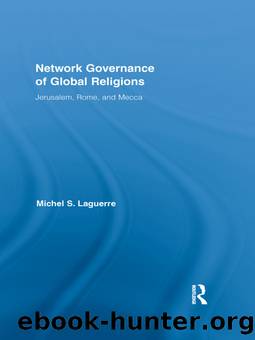Network Governance of Global Religions by Michel S. Laguerre

Author:Michel S. Laguerre [Laguerre, Michel S.]
Language: eng
Format: epub
Tags: Political Science, Globalization, Religion, General, Comparative Religion, Christian Church, Social Science, Sociology, Sociology of Religion, Technology & Engineering, Telecommunications, Social Aspects
ISBN: 9781136775406
Google: LLDfNH1F1aoC
Publisher: Taylor & Francis
Published: 2012-03-28T03:39:29+00:00
CONCLUSION
The global deployment of Catholic Christianity has resulted in the use of a form of network governance that reflects both the values propagated by the faith and the imponderables of trans-border geographical expansion. In the process, the faith has benefited from overseas input including the new infrastructural or institutional matrix that molds its mode of engagement in diverse environments. Catholic Christianity has established itself as a global religion and used a corporate network governance structure, which displays singular features different from any other models discussed in this book.
The corporate network governance model has evolved over time to meet the expansive needs of the global Church. On occasions, Canon law establishes the norms for such a linkage, yet at other times local practices are simply formalized, as we have seen in the case of the Eastern Christian churches. In other words, this is not a preplanned model applied everywhere, but rather a model that has emerged based on practice and experience. It both captures the vertical axis and the horizontal connections of the Church that are the centrality of the papacy and the role of bishops in that structure of network governance.
The structure of the network management of the Catholic Church has also evolved over time in response to internal and external crises. One can think of the role of the Holocaust in the establishment of an Interfaith Dialogue Department in the Curia. In addition, the management of the corporate network governance of the institution can also be seen in the evolution of Church practices. For example, major doctrinal, liturgical, and administrative changes are discussed and agreed upon by the network leadership structure during synods before they can be implemented. The initiative for such changes comes either from the Vatican or from any node of the network, oftentimes as a result of local experimentation. In this light, one may add that nodes contribute to both the exercise of the network leadership and the orthodox interpretation of the content of the faith.
Two of the peculiarities of network governance are that it accommodates nodes that operate in diverse environments and that some units are stronger than others. In such an environment, the network gains its stability from navigating in an uneven architecture of relationships. The leadership network may develop differentiated policies to account for the uniqueness of the position of some nodes, as we have seen in the case of the relations of the Holy See with Eastern Catholic Christianity, or it may simply establish differentiated rules of engagement to define modes of interaction among nodes and between nodes and the corporate hierarchical structure of authority.
Corporate network governance is a mobile and variable site of crisscrossing financial, doctrinal, administrative, leadership, institutional, and infrastructural networks. These diverse networks provide the backbone for the governance of various dimensions of the Church. They crisscross because they are in synergy with each other, because no one bureaucracy can handle all of these aspects of governance by itself, because of the interdependence of nodes, and because the success
Download
This site does not store any files on its server. We only index and link to content provided by other sites. Please contact the content providers to delete copyright contents if any and email us, we'll remove relevant links or contents immediately.
Grails in Action by Glen Smith Peter Ledbrook(9163)
Sass and Compass in Action by Wynn Netherland Nathan Weizenbaum Chris Eppstein Brandon Mathis(8808)
Azure Containers Explained by Wesley Haakman & Richard Hooper(7444)
Configuring Windows Server Hybrid Advanced Services Exam Ref AZ-801 by Chris Gill(7433)
Kotlin in Action by Dmitry Jemerov(7263)
Running Windows Containers on AWS by Marcio Morales(6984)
Microsoft 365 Identity and Services Exam Guide MS-100 by Aaron Guilmette(5402)
Microsoft Cybersecurity Architect Exam Ref SC-100 by Dwayne Natwick(5212)
Combating Crime on the Dark Web by Nearchos Nearchou(4981)
The Ruby Workshop by Akshat Paul Peter Philips Dániel Szabó and Cheyne Wallace(4670)
Management Strategies for the Cloud Revolution: How Cloud Computing Is Transforming Business and Why You Can't Afford to Be Left Behind by Charles Babcock(4527)
Python for Security and Networking - Third Edition by José Manuel Ortega(4233)
The Age of Surveillance Capitalism by Shoshana Zuboff(4209)
Learn Wireshark by Lisa Bock(4119)
The Ultimate Docker Container Book by Schenker Gabriel N.;(3888)
Learn Windows PowerShell in a Month of Lunches by Don Jones(3681)
DevSecOps in Practice with VMware Tanzu by Parth Pandit & Robert Hardt(3568)
Windows Ransomware Detection and Protection by Marius Sandbu(3541)
Blockchain Basics by Daniel Drescher(3507)
